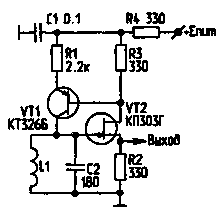To generate high-frequency harmonic oscillations are most commonly used three-point generators. In some cases (for design reasons) can be a useful point-to-point generator. This generator requires the use of two transistors.
However, in a properly designed two-point generator (see figure) the total number of elements can be even less than the three point. Due to the fact that the signal from the oscillating circuit LI, C2 generator is supplied to the gate of the VT2 having a large input resistance and the feedback signal is removed from the collector VT1, having a large output impedance, the resonant circuit is very weakly shunted by an electronic circuit and maintains its high quality. In addition, to increase the input impedance of the FET VT2 in the chain of its source resistor R2, to increase the output resistance of a bipolar transistor VT1 in the circuit of emitter resistor is R1

For this scheme has been determined experimentally that the frequency drift over 1 C does not exceed 1...2 Hz to 10 MHz, i.e. short-term frequency stability of this oscillator is close to the frequency stability of the crystal oscillator. Long-term stability of the frequency is much worse, and is mainly determined by the stability of the resonant frequency of the oscillating circuit and power supply voltage. The change in supply voltage of 1 V leads to the departure frequency of approximately 1000 Hz.
With the same oscillatory circuit in the three-point generator bipolar transistor according to the scheme with a common base frequency drift over 1 s was of the order of 50 Hz.
To increase frequency stability it is desirable to select the resistance of the resistor R3, the value of which determines the depth of positive feedback. With the decrease of the oscillation frequency can increase the resistance of the resistors R1, R2 and R3 to reduce quiescent current generator
Literature
1. Petin G. Transistor amplifiers, generators and stabilizers. - M.: Energy, 1978
2. Horowitz P., hill U. Art circuitry. T. 1. - M.: Mir, 1993
3. Titze U., Schenk, K. Semiconductor circuitry. - M.: Mir, 1982. - 296 with
Author: G. Petin, Rostov-on-don; Publication: N. Bolshakov, rf.atnn.ru






